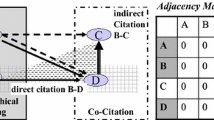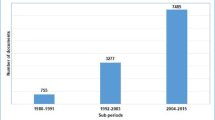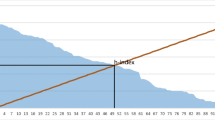Abstract
Information networks, especially citation networks, have many proven and potential applications in scientometrics. Identification of productivity of authors and journals is one of the prime concern of analysts. While there are many indices to measure the productivity of author or journal, there is no known index to determine productivity with respect to a particular research context. A network scientometric approach is devised to address the identification of contextual productivity. Work-author and Work-journal affiliations modelled as 2 mode networks provide effective means to assess the productivity of authors and journals in a particular research context. In this work, weighted 2 mode networks are created for the analysis of affiliations networks such that weights reflect some citation characteristics of the works in their original citation network. A set of network indices are proposed for the assessment of contextual importance of authors and journals which are illustrated in the case study of Biotechnology for Engineering. Online databases and digital libraries can use these indices to gather insights about most productive authors and journals, along with the search results.




Similar content being viewed by others
References
Barabási, A.-L., & Albert, R. (1999). Emergence of scaling in random networks. Science, 286(5439), 509–512.
Batagelj, V. (2003). Efficient algorithms for citation network analysis. cs/0309023.
Batagelj, V. (2012). Social network analysis, large-scale. In A. Robert Meyers (Ed.), Computational complexity: Theory, techniques, and applications (pp. 2878–2897). New York: Springer.
Batagelj, V., & Cerinšek, M. (2013). On bibliographic networks. Scientometrics, 96(3), 845–864.
Bonacich, P. (1972). Factoring and weighting approaches to status scores and clique identification. Journal of Mathematical Sociology, 2(1), 113–120.
Borgatti, S. P. (2005). Centrality and network flow. Social Networks, 27(1), 55–71.
Borgatti, S. P., & Halgin, D. S. (2011). Analyzing affiliation networks. In J. Scott & P. J. Carrington (Eds.), The Sage handbook of social network analysis (pp. 417–433).
Brughmans, T. (2013). Networks of networks: A citation network analysis of the adoption, use, and adaptation of formal network techniques in archaeology. Literary and Linguistic Computing, 28(4), 538–562.
Chin, W.-S., Zhuang, Y., Juan, Y.-C., Felix, W., Tung, H.-Y., Tong, Y., et al. (2014). Effective string processing and matching for author disambiguation. The Journal of Machine Learning Research, 15(1), 3037–3064.
de Moya-Anegón, F., Vargas-Quesada, B., Chinchilla-Rodríguez, Z., Corera-Álvarez, E., Munoz-Fernández, F. J., Herrero-Solana, V., et al. (2007). Visualizing the marrow of science. Journal of the American Society for Information Science and Technology, 58(14), 2167–2179.
De Nooy, W., Mrvar, A., & Batagelj, V. (2011). Exploratory social network analysis with Pajek (Vol. 27). Cambridge: Cambridge University Press.
de Solla Price, D. J. (1965). Networks of scientific papers. Science, 149(3683), 510–515.
Eck, N. J. V., & Waltman, L. (2010). Software survey: Vosviewer, a computer program for bibliometric mapping. Scientometrics, 84(2), 523–538.
Egghe, L. (2006). An improvement of the h-index: The g-index. ISSI Newsletter, 2(1), 8–9.
Freeman, L. C. (1979). Centrality in social networks conceptual clarification. Social Networks, 1(3), 215–239.
Garfield, E. (1964). Citation indexes for science. Readings in Information Retrieval, 122(3159), 261.
Garfield, E. (2009). From the science of science to scientometrics visualizing the history of science with histcite software. Journal of Informetrics, 3(3), 173–179.
Garfield, E., Paris, S., & Stock, W. G. (2006). Histcitetm: A software tool for informetric analysis of citation linkage. Information Wissenschaft und Praxis, 57(8), 391.
Garfield, E., Sher, I. H., & Torpie, R. J. (1964). The use of citation data in writing the history of science. Technical report, The Institute for Scientific Information.
Hansen, D., Shneiderman, B., & Smith, M. A. (2011). Social network analysis: Measuring, mapping, and modeling collections of connections. Analyzing social media networks with NodeXL: Insights from a connected world (pp. 31–52). Burlington: Elsevier.
Hirsch, J. E. (2005). An index to quantify an individual’s scientific research output. Proceedings of the National academy of Sciences of the United States of America, 102(46), 16569–16572.
Hoel, E. G., Heng, W.-L., & Honeycutt, D. (2005). High performance multimodal networks. In C. B. Medeiros, M. J. Egenhofer & E. Bertino (Eds.), Advances in spatial and temporal databases (pp. 308–327). Springer.
Hummon, N. P., & Doreian, P. (1989). Connectivity in a citation network: The development of dna theory. Social Networks, 11(1), 39–63.
Iwami, S., Mori, J., Sakata, I., & Kajikawa, Y. (2014). Detection method of emerging leading papers using time transition. Scientometrics, 101(2), 1515–1533.
Jo, S. J., Jeung, C.-W., Park, S., & Yoon, H. J. (2009). Who is citing whom: Citation network analysis among hrd publications from 1990 to 2007. Human Resource Development Quarterly, 20(4), 503–537.
Kajikawa, Y., Ohno, J., Takeda, Y., Matsushima, K., & Komiyama, H. (2007). Creating an academic landscape of sustainability science: An analysis of the citation network. Sustainability Science, 2(2), 221–231.
Kejžar, N., Černe, S. K., & Batagelj, V. (2010). Network analysis of works on clustering and classification from web of science. In H. Locarek-Junge & C. Weihs (Eds.), Classification as a tool for research (pp. 525–536). Springer.
Kosmulski, M. (2006). A new hirsch-type index saves time and works equally well as the original h-index. ISSI Newsletter, 2(3), 4–6.
Lathabai, H. H., Prabhakaran, T., & Changat, M. (2014). Affiliations network analysis in scientific citations: A case study of information technology for engineering. In 2014 International conference on data science and engineering (ICDSE) (pp. 151–156). IEEE.
Lathabai, H. H., Prabhakaran, T., & Changat, M. (2015). Centrality and flow vergence gradient based path analysis of scientific literature: A case study of biotechnology for engineering. Physica A: Statistical Mechanics and its Applications, 429, 157–168.
Liu, J. S., & Lu, L. Y. Y. (2012). An integrated approach for main path analysis: Development of the hirsch index as an example. Journal of the American Society for Information Science and Technology, 63(3), 528–542.
Liu, J. S., Lu, L. Y. Y., Lu, W.-M., & Lin, B. J. Y. (2013). Data envelopment analysis 1978–2010: A citation-based literature survey. Omega, 41(1), 3–15.
Lotka, A. J. (1926). The frequency distribution of scientific productivity. Journal of Washington Academy Sciences, 16(12), 317–323.
Park, H., & Magee, C. L. (2016). Tracing technological development trajectories: A genetic knowledge persistence-based main path approach. arXiv:1608.07371.
Porter, A., & Rafols, I. (2009). Is science becoming more interdisciplinary? Measuring and mapping six research fields over time. Scientometrics, 81(3), 719–745.
Prabhakaran, T., Lathabai, H. H., & Changat, M. (2015). Detection of paradigm shifts and emerging fields using scientific network: A case study of information technology for engineering. Technological Forecasting and Social Change, 91, 124–145.
Rafols, I., Porter, A. L., & Leydesdorff, L. (2010). Science overlay maps: A new tool for research policy and library management. Journal of the American Society for information Science and Technology, 61(9), 1871–1887.
Ralph, G. (1967). A computer oriented, graph theoretic analysis of citation index structures. In B. Flood (Ed.), Three Drexel information science research studies (pp. 3–46). Philadelphia: Drexel University Press.
Scardoni, G., & Laudanna, C. (2012). Centralities based analysis of complex networks. Rijeka: INTECH Open Access Publisher.
Seidman, S. B. (1983). Network structure and minimum degree. Social Networks, 5(3), 269–287.
Shibata, N., Kajikawa, Y., Takeda, Y., & Matsushima, K. (2009). Comparative study on methods of detecting research fronts using different types of citation. Journal of the American Society for Information Science and Technology, 60(3), 571–580.
Shibata, N., Kajikawa, Y., Takeda, Y., Sakata, I., & Matsushima, K. (2011). Detecting emerging research fronts in regenerative medicine by the citation network analysis of scientific publications. Technological Forecasting and Social Change, 78(2), 274–282.
Small, H. (1999). Visualizing science by citation mapping. Journal of the Association for Information Science and Technology, 50(9), 799.
Waltman, L., van Eck, N. J., & Noyons, E. C. M. (2010). A unified approach to mapping and clustering of bibliometric networks. Journal of Informetrics, 4(4), 629–635.
Watts, D. J., & Strogatz, S. H. (1998). Collective dynamics of ‘small-world’ networks. Nature, 393(6684), 440–442.
Author information
Authors and Affiliations
Corresponding author
Rights and permissions
About this article
Cite this article
Lathabai, H.H., Prabhakaran, T. & Changat, M. Contextual productivity assessment of authors and journals: a network scientometric approach. Scientometrics 110, 711–737 (2017). https://doi.org/10.1007/s11192-016-2202-0
Received:
Published:
Issue Date:
DOI: https://doi.org/10.1007/s11192-016-2202-0




